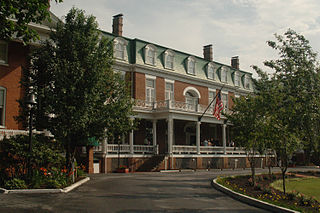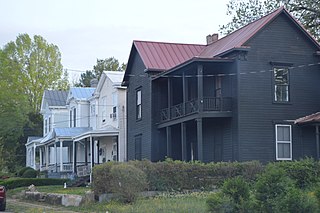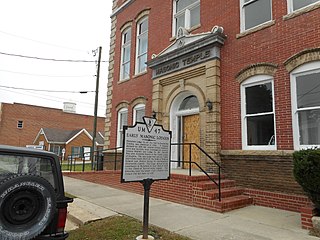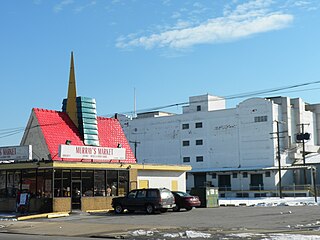
West Point Historic District is a national historic district located at West Point, King William County, Virginia. The district encompasses 75 contributing buildings and 1 contributing object in the town of West Point. The district includes residential, commercial, and institutional buildings and is notable for its variety of late-19th- and early-20th-century styles and building types. Notable buildings include the William Mitchell House, Anderson-Mayo House, Ware House, St. John's Episcopal Church (1882), Mt. Nebo Baptist Church (1887), West Point United Methodist Church (1889), O'Connor Hotel and annex, Treat-Medlin House (1898), Gouldman House (1923), First Baptist Church (1926), U.S. Post Office (1931), West Point Town Office Building, Citizens and Exchange Bank (1923), and Beverly Allen School (1930s).

Buchanan Historic District is a national historic district located at Buchanan, Botetourt County, Virginia. It encompasses 277 contributing buildings, 5 contributing sites, and 4 contributing structures in Buchanan and Pattonsburg on both sides of the James River. They include commercial, transportation-related, domestic, religious, and industrial resources associated with the community's development from the late-18th century through the late-20th century. Notable buildings include the Pattonsburg Mill (1838), Buchanan Presbyterian Church (1845), Trinity Episcopal Church (1842), Hotel Botetourt (1851), Sorrell House (1850), James Evans Mason Lodge (1884), Virginia Can Company complex (1903), "Oak Hill" (1840), Town Hall Municipal Building, Bank of Buchanan, Ransone's Drugstore, Buchanan Theatre (1919), and Buchanan High School (1928). The contributing sites include the James River & Kanawha Canal project site, Johnston-Boyd Cemetery (1835–1906), and Mountain View Cemetery (1854). The contributing structures include the Stone Arch Tunnel (1870s). Also located in the district is the separately listed Wilson Warehouse.

Shenandoah Historic District is a national historic district located at Shenandoah, Page County, Virginia. The district includes 451 contributing buildings, 3 contributing sites, and 4 contributing structures in the town of Shenandoah. They include residential, commercial, and institutional buildings in a variety of popular late-19th century and early-20th century architectural styles. Notable buildings include the Eagle Hotel and annex, Norfolk and Western Railway YMCA, Shenandoah General Store, Fields United Methodist Church, Christ United Methodist Church, St. Peter's Lutheran Church, Norfolk and Western Railway Station, and Shenandoah High School. Located in the district is the separately listed Shenandoah Land and Improvement Company Office.

Spotsylvania Court House Historic District is a national historic district located at Spotsylvania, Spotsylvania County, Virginia. The district includes 24 contributing buildings in the historic core of Spotsylvania. The principal building is the Spotsylvania Court House, a two-story Roman Revival style brick building built in 1839-1840 and extensively remodeled in 1901. The front facade features a tetrastyle portico in the Tuscan order. Associated with the courthouse is a late 18th-century jail and office and storage buildings erected in the 1930s. Other notable buildings include the Spottswood Inn, Berea Church (1856), Christ Church (1841), Dabney Farm, J.P.H. Crismond House, Harris House, and Cary Crismond House.

Abingdon Historic District is a national historic district located at Abingdon, Washington County, Virginia. The district encompasses 145 contributing buildings, 2 contributing site, and 13 contributing structures in the town of Abingdon. It includes a variety of residential, commercial, and institutional buildings dating from the late-18th century to the mid-20th century. Notable contributing resources include Sinking Spring Cemetery, William King High School (1913), General Francis Preston House (1832), Martha Washington Inn, Barter Theatre, the Virginia House, Alexander Findlay House (1827), Gabriel Stickley House, Ann Berry House, Washington County Courthouse (1868), Rev. Charles Cummings House, and James Fields House (1857). Located in the district and separately listed are the Abingdon Bank and Dr. William H. Pitts House.

Kinsale Historic District is a national historic district located at Kinsale, Westmoreland County, Virginia. The district encompasses 65 contributing buildings in the historic core of the village of Kinsale. The district includes primarily residential and commercial buildings dating from the late-19th to early-20th centuries. Notable resources include the Bailey Cemetery, the Great House and Little House, Plain View, Captain Charles Courtney House, former Bank of Kinsale, former Palmer and Moore Kinsale Motor Corporation, Cople District Volunteer Fire Hall Department Building, Kinsale Foundation and Museum, and Kinsale Harbour Yacht Club.

Holbrook–Ross Street Historic District is a national historic district located in Danville, Virginia. The district includes 107 contributing buildings in a primarily African-American neighborhood of Danville. It includes a full range of late 19th and early 20th century residential, commercial, and institutional structures. The majority of the houses are single-family dwellings that were built between 1880 and 1910, and includes notable examples of vernacular Italianate and Queen Anne styles. Notable buildings include the Williams House, Hargraves-Geary House, Tisden House, Leroy Johnson House, Broadnax Apartment, Calvary Baptist Church (1896), Holbrook Street Presbyterian Church, Loyal Baptist Church (1924), Wesley AME Church (1939), Westmoreland Middle School (1936), and the Annex Building (1925). Located in the district are the separately listed Hotel Danville and the Danville Municipal Building.

Belfield–Emporia Historic District, also known as North Emporia, is a national historic district located at Emporia, Virginia. The district includes 41 contributing buildings in the Belfield section of Emporia. In 1887, the neighboring towns of Hicksford and Belfield merged to form the town of Emporia. The district generally consists of late-19th- to early-20th-century brick buildings laid out in a "T"-shape at the intersection of Halifax and Baker Streets. Notable buildings include the Hotel Virginia, the Bethlehem Building or former First National Bank of Emporia (1907), Petersburg and Danville Railroad passenger station, and Pair's Furniture. Located in the district is the separately listed H. T. Klugel Architectural Sheet Metal Work Building.

Hicksford–Emporia Historic District, also known as Emporia, is a national historic district located at Emporia, Virginia. The district includes 36 contributing buildings and 2 contributing objects in the Hicksford section of Emporia. In 1848, Hicksford was a stop on the Petersburg Railroad. In 1887, the neighboring towns of Hicksford and Belfield merged to form the town of Emporia. The district generally consists of late 19th century or early 20th century, when Hicksford–Emporia began to evolve from a small agricultural outpost to a large commercial and governmental center. Located at the heart of the district is the separately listed Greensville County Courthouse Complex. Other notable buildings include the Citizen's National Bank, the Widow's Son's Masonic Lodge (1905), First Presbyterian Church (1907-1908), Emporia Elementary School, Emporia Armory (mid-1930s), Greensville County Auditorium (1934), and Emporia Post Office (1938). The Old Merchants and Farmers Bank Building is also separately listed.

Harrisonburg Downtown Historic District is a national historic district located at Harrisonburg, Virginia. The district encompasses 161 contributing buildings, 1 contributing structure, and 2 contributing objects in the central business district of Harrisonburg. The district includes a variety of commercial, residential, institutional, and governmental buildings dating from the late-18th to mid-20th century. There are notable examples of the Queen Anne and Greek Revival styles.

Poplar Lawn Historic District is a national historic district located in Petersburg, Virginia. The district is named after Petersburg's central park, which spans about two city blocks. In the early 19th century, it was often used as a military parade ground, but during he American Civil War, it became a tent-based detention center and hospital. Later, it became the site of civic celebrations, including possibly the first Memorial Day, on June 9, 1865. The district also includes 372 contributing buildings, mostly mid- to late-19th-century, single-family residences for middle and upper-middle-class families, some constructed of brick, others weatherboard frame, and later subdivided. Residential architectural styles include Greek Revival, Colonial Revival, Second Empire, and Italianate. Notable buildings include the Bolling-Zimmer House, St. Stephen's Church, Zion Baptist Church, William T. Double House, the Waterworks (1856), Dr. Robert Broadnax House (1858), Market Street Methodist Church Parsonage, Maurice Finn House, and the Frank M. D'Alton Double House.

Petersburg Old Town Historic District is a national historic district located at Petersburg, Virginia. The district includes 174 contributing buildings located in the oldest section of Petersburg. It includes a varied collection of late 18th- through 20th-century architecture. Notable buildings include the Strachan-Harrison house, the John F. May house, South Side Railroad Depot, High Street United Methodist Church, Church of Christ (1925), and the Powell Manufacturing Co. Located in the district and separately listed are the Appomattox Iron Works, City Market, Exchange Building, Farmers' Bank and Nathaniel Friend House.

Folly Castle Historic District, also known as the West Washington Street Historic District, is a national historic district located at Petersburg, Virginia. The district includes 189 contributing buildings and 1 contributing object located in a predominantly residential section of Petersburg. It includes a varied collection of late 18th-and 19th-century houses and includes notable examples of Late Victorian, Georgian, Italianate, Queen Anne, and Federal style architecture. Notable buildings include Folly Castle / Peter Jones V residence, McIlwaine-Friend residence (1856-1858), Rambout-Donnan residence, former Petersburg High School (1917-1918), Donnan House, First Baptist Church (1928), Couch House (1850s), and St. John's Episcopal Church (1897). Located in the district and separately listed are the Second Presbyterian Church and Strawberry Hill.

Centre Hill Historic District is a national historic district located at Petersburg, Virginia. The district includes 81 contributing buildings located in a predominantly residential section of Petersburg. It includes a varied collection of early-19th-century to early-20th century houses and includes notable examples of Greek Revival, Italianate, Colonial Revival, and Bungalow style architecture. Notable buildings include the Centre Hill Apartment Building (1915), Eichberg House, Powell House, Unger House, and St. Joseph's Convent. Located in the district and separately listed is the Centre Hill Museum.

South Market Street Historic District is a national historic district located at Petersburg, Virginia. The district includes 15 contributing buildings and 1 contributing object located in a predominantly residential section of Petersburg. It includes a varied collection of mid- to late-19th-century houses and includes notable examples of Late Victorian and Colonial Revival style architecture. Notable buildings include the Mt. Olivet Baptist Church (1858), Scott House (1855), and Williams House (1879). Located in the district and separately listed is the Thomas Wallace House.

Petersburg Courthouse Historic District is a national historic district located at Petersburg, Virginia. The district includes 75 contributing buildings located in the central business district of Petersburg. It is centered on the Petersburg Courthouse and includes notable examples of Greek Revival, Italianate, Federal style architecture. Notable buildings include the Paul-Lassiter House, Slaughter-Tatum House, Tabb Street Presbyterian Church Rectory, Mark E. Holt Jewelry Store, Augustus Wright Block, Virginia National Bank, Saal's Department Store, Remmie Arnold Pens Company building, A&P Super Market, Watson Court Apartments, and the Zimmer & Company Building. Located in the district and separately listed are the Petersburg City Hall, Tabb Street Presbyterian Church, and Saint Paul's Church.

Atlantic Coast Line Railroad Commercial and Industrial Historic District is a national historic district located at Petersburg, Virginia. The district includes 15 contributing buildings, 1 contributing structure, and 1 contributing object located in a predominantly industrial and commercial section of Petersburg. The section housed some of Petersburg's important industries – tobacco and wholesale grocery and confectioner. Notable buildings include the Cameron Building, Export Leaf Tobacco Company (1913), H.P. Harrison Company (1912), Brown & Williamson complex, and Gibson Drive-in.

The Laburnum Park Historic District is a national historic district located at Richmond, Virginia. The district encompasses 226 contributing buildings and 2 contributing structures located north of downtown Richmond. The primarily residential area developed starting in the early-20th century as one of the city's early "streetcar suburbs" and as home to several important local institutions. The buildings are in a variety of popular early-20th century architectural styles including Queen Anne and Colonial Revival. It was developed as neighborhood of middle-to-upper-class, single-family dwellings. Notable buildings include the Laburnum House (1908), Richmond Memorial Hospital (1954–1957), Richmond Memorial Hospital Nursing School (1960–1961), "The Hermitage" (1911), Laburnum Court (1919), Veritas School.

The Highland Park Plaza Historic District is a national historic district located at Highland Park, Richmond, Virginia. The district encompasses 1,005 contributing buildings located north of downtown Richmond and east of Barton Heights and Brookland Park. The primarily residential area developed starting in the late-19th century as one of the city's early "streetcar suburbs." It was added to the National Register of Historic Places in 2004.

Newtown Historic District is a national historic district located at Staunton, Virginia. The district encompasses 414 contributing buildings and 2 contributing sites in a primarily residential section of Staunton. The district includes some late 18th- and early 19th-century structures, but most of the homes were built between 1870 and 1920 during Staunton's boom years. The buildings range from Jeffersonian Neo-Classical and Greek Revival to bungalows of the 1920s. Notable buildings include Stuart Hall's Cochran House (1858), Robertson House (1886), the Smith Thompson House, and the George M. Cochran House. The magnificent grounds of Thornrose Cemetery are also included in the district. Located in the district are the separately listed Stuart Hall School, Stuart House, and Trinity Episcopal Church.
























